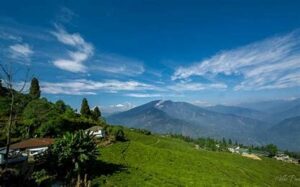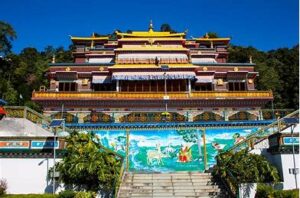Introduction
Losoong, also known as Namsoong, is one of the region’s most important celebrations. It commemorates the start of the Sikkimese New Year. This joyful festival marks the end of the harvesting season. This festival provides a moment of rest and rejoicing for the productive, hard-working farmers who have worked relentlessly all year for the land’s prosperity.
Beyond its agricultural significance, Losoong has evolved into a cultural show, displaying the unique Sikkimese traditions. Sikkimese delicacies, various festivities, and traditions fill the region with lively colors and energy.
Historical Evolution
Initially confined to the Bhutia community, Losoong has gradually expanded its cultural boundaries. The Lepchas and other minor tribes in Sikkim, Darjeeling, and Nepal celebrate this festival now. Its roots are set in the agrarian lifestyle of Sikkim. It offers farmers a well-deserved opportunity to rejoice in the fruits of their labor. The enjoyment and celebration primarily take place with family and friends. However, the entire region radiates a festive aura during that time of the year.
The streets are decorated with colorful flags many nights before the festival. They create a beautiful contrast against the snow-capped mountains. Monasteries and monks prepare for extensive celebrations. Local sports competitions add a competitive edge to the festivities.
Duration and Timing
The Losoong festival’s timing is closely tied to the Tibetan Lunar Calendar, typically falling on the 18th day of the 10th lunar month. It usually falls in December in the Gregorian calendar. This four-day fest has various cultural events. The center stage of events takes place in the well-known ancient monasteries such as Rumtek and Tsuklakhang Palace. As the festival goes on, the locals meet and mingle to see and take part in the aura of joy and color.
Cultural show
Losoong has emerged as a beacon of Sikkimese culture. The festival displays the deep-rooted spiritual and artistic heritage of the region. Traditional folk dances, religious rituals, and ceremonies are performed. Monasteries like Rumtek and Tsuklakhang Palace are the focal points for cultural events, where various performances take place.
The Black Hat dance also takes place during the festival. It is a reminder to the locals of the victory of good over evil. It encourages Sikkim’s rich history and traditions by narrating stories of fame. The festival serves as a platform for the artistic expression of the local communities, bringing together musicians, dancers, and artisans to create an environment of the Sikkimese culture.
Important Rituals
Losoong’s customs and ceremonies are mostly borrowed from Losar, another well-known Sikkim celebration that celebrates the start of the Tibetan New Year. The close proximity that Sikkim shares with Tibet has assimilated many of their rituals and ways of living.
The Cham dances performed by Buddhist Monks are the festival’s main highlights. The whole place is covered with well-crafted colorful costumes and get up. There are varied folk music and heart-pounding acrobat maneuvers by masked dancers. Archery contests and a delicious buffet of native Sikkimese food are also part of the celebrations, which are eagerly anticipated by all visitors and tourists.
Religious Significance
Losoong holds profound religious significance as this celebration is profoundly rooted in the spiritual beliefs of Sikkim. Monasteries too, play a crucial role in this. It is believed that bad luck and misfortunes are eliminated as monks chant and conduct strict rituals and ceremonies. They seek blessings from the Gods and Goddesses for the upcoming year.
The air is filled with harmonious chants and prayers that align with the spiritual beliefs of the festival. Pilgrims and devotees join the monks in these sacred observances, fostering a sense of unity and devotion within the community. The union of religious traditions and festive cheer creates a unique atmosphere, making Losoong a holistic celebration that is away from the mundane existence of everyday life of the people living here.
Culinary Delights
No celebration is complete without indulging in the local cuisine, and Losoong is no exception. Sikkimese dishes that reflect the region’s culinary diversity are a part of this festival. From traditional delicacies to modern interpretations, every food palate is prepared.
Aalum,babar,furaula and gundruk are some of the traditional dishes consumed during the festival. Firstly the food is offered to the Gods. Once that happens, people wear new clothes or traditional clothes named bhangra , kachhad and gunyu cholo. In the older times, people used to wash their old clothes to celebrate this festival. After seeking blessings from the elders, food is served and the celebration begins.
Global Attraction
In recent years, Losoong has garnered global attention. The locals have attracted tourism to boost their economy. This festival has earned a reputation as one of the most sought-after festival tour destinations in North East India. Thousands of tourists from across the globe travel to Sikkim each year to experience the cultural display of Northeast India against the backdrop of snow-peaked Himalayan mountains.
The festival provides an experience of the traditions and customs of the Sikkimese people, their way of life and living. The influx of visitors not only contributes to the local economy but also fosters cultural exchange, as people from diverse backgrounds come together to celebrate the spirit of Losoong.
Conclusion
Losoong is Sikkim’s pride in retaining its cultural richness while accepting modernity. Combining agricultural festivals with spiritual observance, the locals creatively display the authentic culture of Sikkim. The festival continues to draw a worldwide audience. This not only supports the region’s cultural identity but also acts as a bridge, bringing people from all over the world together in a common celebration of tradition and variety. Losoong, with its appealing mix of history, spirituality, and celebrations, captures the essence of Sikkim’s culture as they welcome the New Year.Unravelling a billion untold stories, one chapter at a time, Humans of Northeast takes you on a discovery through vibrant Northeast India – a land rich in people, places, and culture. Ready to immerse yourself in more such stories? Visit our page HONEI to read more about narratives that inspire and uplift.




